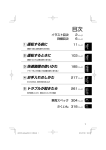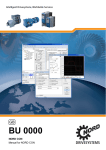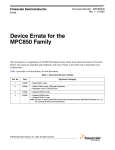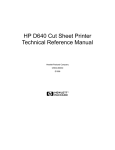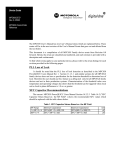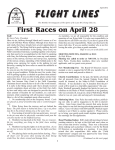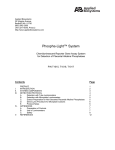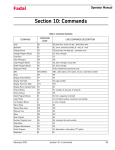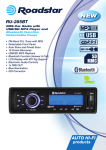Download service and operation manual - Pyles Pumps Value Added Systems
Transcript
RoadStar & HighwayStar Pump Service Manual SERVICE AND OPERATION MANUAL ROADSTAR AND HIGHWAYSTAR JOINT SEALANT PUMP SYSTEMS © 2000-2001 braydenwërks, inc. Page 1 RoadStar & HighwayStar Pump Service Manual SOME OF THE AIR CONTROL ITEMS MAY HAVE BEEN REMOVED FOR PROTECTION DURING SHIPPING. FOLLOW THE INSTRUCTIONS BELOW TO RE-INSTALL THEM. MOUNT THE VALVE WITH THE FOUR ALLEN HEAD CAP SCREWS PROVIDED. THE LOCK WASHERS BELONG UNDER THE HEAD OF THE SCREW AND ON TOP OF THE VALVE. © 2000-2001 braydenwërks, inc. Page 2 RoadStar & HighwayStar Pump Service Manual CONNECT THE AIR LINE TUBING. MATCH THE IDENTIFYING TAG OR TAPE STRIP TO THE FITTING, INSERT THE TUBE INTO THE FITTING AND PUSH UNTIL IT SEATS. IF YOU HAVE TO REMOVE THE TUBING, PUSH IN ON THE SMALL RING AT THE FITTING INLET WHILE PULLING OUT ON THE TUBING WITH THE OTHER HAND. CONNECT THE FOLLOWER PLATE DRUM BLOW OFF HOSE ONTO THE FOLLOWER PLATE FITTING. © 2000-2001 braydenwërks, inc. Page 3 RoadStar & HighwayStar Pump Service Manual MOUNT THE ELEVATOR CONTROL REGULATOR THREAD THE REGULATOR FITTING INTO THE OUTLET FITTING OF THE MAIN AIR CONTROL. TIGHTEN REGULATOR IN PLACE WITH 11/16” WRENCH. STOP WHEN SNUG AND THE GAUGE FACES FORWARD. © 2000-2001 braydenwërks, inc. Page 4 RoadStar & HighwayStar Pump Service Manual CONNECT THE COILED HOSE FROM THE ELEVATOR CONTROL VALVE TO THE REGULATOR. THE FITTING SWIVELS. USE A 9/16” WRENCH ON THE HEX CLOSEST TO THE THREADS. © 2000-2001 braydenwërks, inc. Page 5 RoadStar & HighwayStar Pump Service Manual Value Added Systems Incorporated WARRANTY REGISTRATION Goods and equipment sold by Value Added Systems, Inc. are covered by the original manufacturer’s warranty. All warranty claims must be processed through us. To register the warranty, this form must be returned to us by fax or by mail at the time the equipment is received by the end user. If the warranty is not registered, the original shipping date from our facility or the manufacturer’s plant will be used as the beginning of the warranty period. Company Name _____________________________________________________________ Mailing Address _____________________________________________________________ City, State (Prov), Zip (Post Code) _______________________________________________ Shipping Address ____________________________________________________________ City, State (Prov), Zip (Post Code) _______________________________________________ Phone _____________________________________________________________________ Fax _______________________________________________________________________ E-mail _____________________________________________________________________ Model _____________________________________________________________________ Ship Date __________________________________________________________________ Setup / First Use Date ________________________________________________________ Experience Counts – Count On Ussm Value Added Systems, Inc. • PO Box 2335 • Denton, Texas 76202 • 940.566.2508 • Fax 940.382.1164 Technical Support 800.825.2379 • Fax Orders 800.736.4119 URL http://www.dispense.com • e-mail: [email protected] © 2000-2001 braydenwërks, inc. Page 6 RoadStar & HighwayStar Pump Service Manual © 2000-2001 braydenwërks, inc. Page 7 RoadStar & HighwayStar Pump Service Manual PRELIMINARY SETUP You will need simple hand tools, rags or paper towels, several large drink cups or small coffee cans, petroleum jelly and a trash bag. 1. Remove all shipping and packaging material. Inspect for shipping damage. Report any damage to the carrier immediately. Remove the pump from the shipping skid. 2. Un-pack any boxes that were shipped with the pump. These may include the tool kit, air line lubricant, pump throat packing seal fluid, pieces for the dispensing wand and elevator control valve handle. 3. Check all external nuts and bolts for any that may have loosened in-transit, including the air motor-to-pump shaft coupling and the air motor-to-elevator crossbar connections. Tighten as necessary. 4. Locate the air line lubricant. Add it to the air line lubricator through the fill port on the top. Fill it at least half way. Do not mix up the airline oil and the throat packing lubricant. 5. Locate the pump packing seal fluid; add about half of it to the packing nut cavity. 6. Tighten the packing nut with the face spanner wrench provided. It is shipped slightly loose. 7. If included, extend pump shaft bellows over the packing nut and secure in place with the clamp provided. 8. Check the air bleed valve on the back of the pump head. Make sure that the center stem is screwed all the way in. Use the hex wrench provided. 9. If it was removed for shipment, locate the elevator control valve handle (chrome plated, about 4” long with a grey knob) and install it in the valve. Some type of liquid thread lock is recommended. © 2000-2001 braydenwërks, inc. Page 8 RoadStar & HighwayStar Pump Service Manual INSTALLATION – GENERAL 1. Make sure that there is at least 8 feet of overhead clearance. 2. Make sure that the air supply hose is of adequate length, and has ample clearance, so that it can move up and down with the pump during drum changes. 3. Main supply air must have a shut off valve at its source. 4. Do not use any quick disconnect type fittings or valves with an inside diameter less than ½”. INSTALLATION – FACTORY Securing the pump to the factory floor is recommended after it has been in operation for a short period of time and the proper location for the application has been determined. Proper concrete anchor screws must be used in most floors. INSTALLATION - TRUCK OR TRAILER MOUNTED 1. Position the pump on the truck or trailer where it will be used. Typically the pump is located on the driver's side towards the rear. The hose goes out over the side where the driver can watch it in the mirror. The drums are loaded from the middle of the truck or trailer. The air source is typically a tow-along compressor. The pump is set up to accommodate this arrangement. The pump may be reconfigured into a mirror image (except for the elevator control valve) if this is better for your installation. 2. CAUTION: We strongly advise that you secure the pump to the bed of the truck or trailer using the four 1/2" holes in the corners of the elevator base plate; (even though we sell a reasonable number of parts each year to people who turn their pumps over, or drop them off the truck completely.) The shipping bolts ARE NOT adequate for this purpose. They are either grade 2 or un-graded hardware store variety bolts. 3. Open the air motor control valve (move the handle parallel to the valve body). Increase pressure on the main regulator until the air motor starts to cycle. After one or two cycles, turn off the air motor control valve (move the handle perpendicular to the valve body). 4. Remove the barrel locator clamp pin and swing the front of the clamp full open. (The clamp may be mounted for either right or left opening, whichever suits the installation.) 5. If used, install the extension hose to the pump outlet fitting. Attach the hose support clamp to the elevator crossbar bracket. (If purchased with a new pump, it may be shipped pre-installed). © 2000-2001 braydenwërks, inc. Page 9 RoadStar & HighwayStar Pump Service Manual 6. Straighten out the main material hose with the swivel and short whip hose. Tighten all connections and install the dispense valve or pistol grip flow gun if used. 7. Check that the dispense valve is closed. On units with a ball valve, a mark has been engraved on the valve handle keeper washer. The mark indicates the direction of the port in the ball. WITH the valve is OPEN, ACROSS the valve is CLOSED. Leave the long wand off. 8. Connect the dispense hose directly to the pump using the adapter fitting provided with the hose, or connect it to the swivel on the extension hose, if used. If the hose is connected directly to the pump, use the support clamp provided to anchor the hose to the elevator crossbar. This clamp is not used if an extension hose is installed. 9. Check that the elevator control valve handle is set in the neutral position (horizontal) and that the small brass valve on the blow-off hose is closed. 10. NOTE: THE “NEUTRAL” POSITION OF THE ELEVATOR CONTROL VALVE DOES NOT LOCK THE ELEVATOR IN POSITION. IF THE ELEVATOR IS LEFT IN THE RAISED POSITION AND AIR IS LEAKING OR DISCONNECTED FROM THE SYSTEM, THE ELEVATOR WILL EVENTUALLY LOWER AND HAS THE POTENTIAL OF CAUSING DAMAGE OR INJURY. USE CARE, CAUTION AND COMMON SENSE WHEN WORKING AROUND THIS, OR ANY, PIECE OF EQUIPMENT. 11. Check that the main follower plate bleed port (hook shaped handle screwed into the plate) is installed and that the blow-off stem valve is closed. 12. Check that the blow-off hose from the elevator control valve to the follower plate blow-off stem is NOT connected, and that the hose is draped outside of the barrel locator hoop. 13. Connect the main airline to the air inlet coupling provided. ¾” I.D. air hose with a minimum length of 25’ is recommended. Maximum inlet pressure must be limited to 125 PSI. Minimum volume required is 50 SCFM clean dry air. 14. Check that the air motor air valve is closed (handle is perpendicular to the valve body). Place the elevator valve in the DOWN position. (Move the handle from horizontal neutral position to point down at a 45° angle.) 15. Blow out any moisture from the air supply line. Use a minimum of 3/4" I.D. hose 25' long. (50’ is preferred; air must have a chance to cool after leaving the compressor.) Connect the main air supply and turn it on. If everyone has done everything correctly at this point nothing will happen. If anything leaks, or moves, turn off the main air supply and go back over the steps above. If there is still a problem, call your reseller or the tech support number in the back of the book for advice. 16. Check that the drum clamp is completely open. © 2000-2001 braydenwërks, inc. Page 10 RoadStar & HighwayStar Pump Service Manual 17. Set the elevator regulator pressure to 40 PSI. Move the elevator control valve from the 45° down position to the 45° up position. The elevator should start to rise. a. With no drum in place, it may be necessary to pull the pump forward to allow the follower plate seals to clear the back of the drum locator clamp. Grab the upright bars that connect the follower plate to the elevator crossbar and pull the pump forward enough that the drum seals can clear the back drum locator. DO NOT GRAB THE FOLLOWER PLATE ITSELF. With no drum in place a possible pinch point exists between the follower plate and the drum locator clamp. This condition does not normally exist on a pump that is in production, only on new pumps during set-up. b. On pumps with the black o-ring style follower plate seals, the upper seal may roll out of its groove if it contacts the drum locator clamp while raising the elevator with no drum in place. Roll the seal back into the groove and continue. 18. Move the elevator control valve to horizontal neutral as soon as the follower plate clears the drum locator clamp. 19. Check for overhead clearance of at least eight feet. Check that the material hose is not caught on the pump or any surrounding equipment. 20. Move the elevator control valve from horizontal neutral to 45° up position. Allow the elevator to rise to the full-extended position. 21. Move the elevator control valve from the 45° up position to the 45° down position. Allow the elevator to lower to the base plate. It may be necessary to pull the pump forward to allow the drum seals to clear the back drum locator. Leave the handle in the 45° down position. 22. Open the main air valve to the pump air motor. 23. Adjust the air motor regulator until the pump just starts to cycle. 24. After 2 or 3 cycles (cycle = up and back down), close the main air valve with the pump in the full DOWN stroke of the air motor. 25. NOTE: The pump primer plate bolt head may hit the base plate when there is no drum installed. You will hear it, and the pump will rise slightly at the same time. This is normal. © 2000-2001 braydenwërks, inc. Page 11 RoadStar & HighwayStar Pump Service Manual FIRST DRUM INSTALLATION 1. Be prepared to use the pump the same day that you install the first drum. It takes several gallons of material to assure that all of the air is initially purged from the system. It is better to put this material into a joint than to throw it away. Air trapped in the pump the first day may cause material to cure inside the pump or hose. If you want to prime the pump in your yard before taking it out on a job, dispense at least 3 – 4 gallons of material before shutting it down. NOTE: Handling the drum up to the pump and placing it on the edge of the pump base plate is normally a two person job. FOR OPERATOR SAFETY, FINAL POSITIONING OF THE DRUM UNDER THE PUMP AND OPERATING THE ELEVATOR CONTROL VALVE MUST BE DONE BY THE SAME PERSON! Do not lower the pump into the drum without looking to make sure there is nothing that could be trapped between the pump and the drum. USE CARE, CAUTION AND COMMON SENSE WHEN WORKING AROUND THIS, OR ANY, PIECE OF EQUIPMENT. 2. Clean any debris from the top of the material drum. 3. Remove the drum lid clamp. 4. Pick the lid straight up off of the drum. Do not grab it by one edge and tip that edge up. This will cause any water or dirt on top of the lid to fall into the drum. 5. Remove any plastic cover that may be shipped inside the drum. Discard in the trash bag. 6. If equipped, pull the drum liner straight and tight. Pull the open end down over the outside of the drum. It is important that the liner does not bunch up under the follower plate. This may cause the liner to be sucked up into the pump. 7. Move the elevator control valve from 45° down to the 45° up. Allow the elevator to rise to the full-extended position. 26. NEW PUMPS: Look under the follower plate. In the center of the pump inlet you will see the pump primer plate. This helps load material into the pump when it is operating. If anything gets caught in the pump inlet, NEVER PUT YOUR FINGERS ABOVE THE PRIMER PLATE TO REMOVE THE OBSTRUCTION. Do not even put any tools you like in there without first backing the pump air regulator back to zero AND closing the air motor air valve. (You have to keep the main air on to assure that the elevator stays in the up position.) USE CARE, CAUTION AND COMMON SENSE WHEN WORKING AROUND THIS, OR ANY, PIECE OF EQUIPMENT. 8. With new follower plate seals, coat them with petroleum jelly (Vaseline® or similar) or use some of the pump throat packing seal fluid on a cloth. This is only necessary with new seals. 9. Position the new barrel next to the pump base plate. Tip the drum back and “walk” it up onto the two skid rails on the pump base. Push the barrel onto the pump base until it stops against the rear barrel locator clamp. 10. Close the open half of the barrel locator clamp and re-insert the pin thru the hinge. © 2000-2001 braydenwërks, inc. Page 12 RoadStar & HighwayStar Pump Service Manual 11. Move the elevator valve handle to the 45° down position and lower the pump onto the drum. Make sure that the follower plate is centered in the drum opening. 12. It may be necessary to increase the elevator down pressure to 80 or 100 PSI to force new follower seals into the barrel. If so, remember to reduce the pressure back to 40 PSI. 13. Once the follower plate seals touch the top of the drum, air will be trapped between the follower plate and the surface of the material in the drum. Open the ball valve on the blow-off stem. Air should exhaust from the stem. Place your thumb over the stem to stop the flow of air. The follower plate will also stop lowering into the barrel. Remove your thumb again and listen/feel for the air flow to stop. Immediately close the ball valve on the blow-off stem. 14. Removing the hooked handle bleed plug from the follower plate is a faster way to bleed the air from under the follower plate, but it always makes a mess on top of the plate unless you are very careful. 15. Leave the elevator control valve in the 45° down position. Make sure the regulator is set about 40 PSI. 16. Stretch the dispense hose out straight. Make sure the dispense valve is still closed. 17. Hold a large cup under the air bleed valve on the pump head. 18. Open the bleed valve center stem 2 or 3 turns with the hex wrench provided. 19. Open the main air motor air valve. The pump should start to cycle slowly. If it does not, slowly increase the air pressure on the main regulator until the pump starts to cycle. 20. As the pump starts to prime, it may slow down or stop. Slowly increase the air pressure on the main regulator until the pump keeps cycling. 21. Observe material flowing out of the air bleed valve on the pump head. Continue, changing cups as necessary, until the material is flowing for the complete up and down stroke, and air bubbles quit “popping”. Close the bleed valve stem with the wrench provided. 22. Open the dispense valve. Point the dispense tip into the trash bag or a large cup or small can. Elevate the hose as much as possible to help trapped air escape. 23. It may be necessary to increase the pressure on the main air motor regulator as the hose fills with material. 24. Allow material to flow from the dispense tip until it is air free. 25. Shut off the dispense valve. The pump should stop wherever it is in the stroke. If it does not, there is still air trapped in the pump or the hose. (If the pump stops in one direction but not the other, this is an indication that something is caught in one of the two check valves.) 26. Open and close the dispense valve several times for the operator to get the feel of starting and stopping the material flow. © 2000-2001 braydenwërks, inc. Page 13 RoadStar & HighwayStar Pump Service Manual 27. With the dispense valve open, adjust the main air motor regulator for the desired material flow rate. 28. With the dispense valve open and the pump running, observe the view dome on the air motor lubricator. There should be one drop of oil form and fall every 1 – 2 minutes while the pump is operating. Typically ¼ - ½ turn from fully closed on the lubricator adjustment knob is adequate. 29. Install the dispense wand by threading it onto the outlet of the dispense gun or valve. Loosen and adjust the wand guide handle and the shut-off valve handle until they are comfortable for the operator. On units with a ball valve shut-off, the valve handle may be removed and repositioned in any of eight locations if one of these is better for the operator. The on-off lever may also be operated horizontally or vertically depending on the operator’s preference. © 2000-2001 braydenwërks, inc. Page 14 RoadStar & HighwayStar Pump Service Manual DRUM CHANGING 1. When you observe the elevator piston shafts are almost fully retracted, and then hear the pump cycle rate increase sharply, the drum is empty. 2. Immediately close the dispense valve and the main air motor air valve. 3. Clean any debris from the top of the new material drum. 4. Remove the drum lid clamp. 5. Pick the lid straight up off of the drum. Do not grab it by one edge and tip that edge up. This will cause any water or dirt on top of the lid to fall into the drum. 6. Remove any plastic cover that may be shipped inside the drum. Discard in a trash bag. 7. If equipped, pull the drum liner straight and tight. Pull the open end down over the outside of the drum. It is important that the liner does not bunch up under the follower plate. This may cause the liner to be sucked up into the pump. 8. Connect the blow-off air hose to the blow-off stem. Open the ball valve on the blow-off stem. 9. Open the ball valve on the other end of the blow-off hose. 10. Move the elevator control valve from the 45° down position to the 45° up position. The pump should start to rise from the drum. 11. When the follower plate is close to the top of the drum, repeatedly move the elevator control valve from the 45° up position to the horizontal neutral position to ease the pump up out of the drum. Leave the valve in the 45° up position. 12. Close the ball valve at the top of the blow-off hose. Allow the elevator to rise to the fully extended position. 13. With a putty knife and rag or paper towels, clean most of the material from the follower plate seals. Especially clean any material that has gotten on top of the follower plate. 14. Pull the pin from the barrel locator clamp and swing the front half fully open. 15. For operator safety, remove the empty drum by pushing it out FROM THE BACK. Do not grab it by the top lip and pull it out from the front. 16. Check the bottom of the follower plate for cured material. Remove with a putty knife or similar tool. Make sure that the elevator control valve is in the 45° up position, that the blow off hose is disconnected and that the main air is on so that the elevator cannot move while you are cleaning. 17. NOTE: Handling the drum up to the pump and placing it on the edge of the pump base plate is normally a two person job. FOR OPERATOR SAFETY, FINAL POSITIONING OF THE DRUM UNDER THE PUMP AND OPERATING THE ELEVATOR CONTROL VALVE MUST BE DONE BY THE SAME PERSON! © 2000-2001 braydenwërks, inc. Page 15 RoadStar & HighwayStar Pump Service Manual 18. Position the new barrel next to the pump base plate. Tip the drum back and “walk” it up onto the two skid rails on the pump base. Push the barrel onto the pump base until it stops against the barrel locator clamp. 19. Close the open half of the barrel locator clamp and re-insert the pin thru the hinge. 20. Check for hoses or other objects between the follower plate and the top of the drum. 21. Move the elevator valve handle to the 45° down position and lower the pump onto the drum. Make sure that the follower plate is centered in the drum opening. 22. Once the follower plate seals touch the top of the drum, air will be trapped between the follower plate and the surface of the material in the drum. Open the ball valve on the blow-off stem. Air should exhaust from the stem. Place your thumb over the stem to stop the flow of air. The follower plate will also stop lowering into the barrel. Remove your thumb again and listen/feel for the air flow to stop. Immediately close the ball valve on the blow-off stem. 23. Leave the elevator control valve in the 45° down position. 24. Hold a large cup under the air bleed valve on the pump head and open the bleed valve center stem 2 or 3 turns with the wrench provided. 25. Open the main air motor air valve. Observe material flowing out of the air bleed valve on the pump head until air bubbles quit “popping”. Close the bleed valve stem. © 2000-2001 braydenwërks, inc. Page 16 RoadStar & HighwayStar Pump Service Manual NIGHTLY SHUT-DOWN 1. Turn off the main air motor air valve. 2. Open the dispense valve until all fluid pressure bleeds from the system. 3. Turn off the compressed air at its source. 4. Remove the tip from the dispense wand. Soak the tip overnight in a can of mineral spirits or other suitable solvent. 5. Install a pipe cap or plug in place of the dispense tip. This will keep atmospheric moisture away from the material in the dispense wand, which will cause silicone and urethane products to cure. DAILY START-UP 1. Clean out and replace dispense tip. 2. Check level of oil in the lubricator. 3. Check that elevator control valve is in the 45° down position. 4. Check that the main air motor air valve is off. 5. Turn on main air supply. 6. Turn on main air motor air valve. 7. Check both the air motor and the elevator pressure gauges for normal settings. 8. Open dispense valve and test for material flow rate. © 2000-2001 braydenwërks, inc. Page 17 RoadStar & HighwayStar Pump Service Manual THE PUMP WILL NOT COME OUT OF THE DRUM STEP ONE: 1. REMOVE THE "BLOW OFF TUBE" FROM THE FOLLOWER PLATE. THIS IS THE ASSEMBLY OF THE ¼” PIPE NIPPLE, ¼” BRASS BALL VALVE AND THE QUICK DISCONNECT STEM THAT IS THREADED INTO THE FOLLOWER PLATE. UNSCREW IT FROM THE FOLLOWER PLATE AND OPEN THE BALL VALVE. STICK A WIRE COAT HANGER OR SIMILAR THROUGH IT TO MAKE SURE IT IS COMPLETELY OPEN FROM END TO END. 2. IF IT IS NOT OPEN, TAKE IT APART AND CLEAN IT, OR BUY SIMILAR ITEMS AT A HARDWARE STORE OR PLUMBING SUPPLY TO DUPLICATE IT. 3. WHEN IT IS COMPLETELY OPEN, CONNECT IT BACK TO THE AIR HOSE. OPEN THE BALL VALVE ON THE BLOW OFF TUBE AND THE BALL VALVE AT THE OTHER END OF THE HOSE. PLACE THE ELEVATOR CONTROL VALVE IN THE UP POSITION. AIR SHOULD BLOW OUT OF THE BLOW OFF TUBE. IF IT DOES NOT, THEN THE AIR HOSE AND/OR THE QUICK DISCONNECT SOCKET AT THE END OF THE AIR HOSE IS PLUGGED. THESE PIECES CAN BE REPLACED WITH SIMILAR COMMERCIAL ITEMS FROM A HARDWARE STORE OR POSSIBLY FROM AN AUTO PARTS STORE. 4. BOTH THE AIR HOSE AND BLOW OFF TUBE ARE MUST BE CLEAR TO REMOVE THE PUMP FROM THE DRUM. RE-INSTALL THE BLOW OFF TUBE BACK INTO THE FOLLOWER PLATE. YOU SHOULD BE ABLE TO CHANGE THE DRUM AS NORMAL. STEP TWO: 1. IF THE FIRST TROUBLESHOOTING TIP DOESN'T WORK, PULL THE DRAW PIN FROM THE DRUM LOCATOR CLAMP, AND SWING OPEN THE CLAMP. 2. PLACE THE ELEVATOR CONTROL VALVE IN THE UP POSITION. DO NOT OPEN THE BLOW OFF TUBE VALVE. IF THE ELEVATOR CONTROL VALVE IS WORKING PROPERLY, THE ELEVATOR SHOULD RAISE AND PICK UP THE EMPTY DRUM WITH THE PUMP. a. IF YOU CAN PICK UP THE EMPTY DRUM, AND IF THE BLOW OFF TUBE AND HOSE ARE FUNCTIONING CORRECTLY, THE DRUM IS GLUED TO THE FOLLOWER PLATE WITH CURED MATERIAL. YOU WILL HAVE TO BREAK THE BOND ALL THE WAY AROUND WITH A PRY BAR OF SOME SORT. b. IF YOU CANNOT PICK UP THE EMPTY DRUM, EITHER THE ELEVATOR CONTROL VALVE OR THE REGULATOR FEEDING AIR TO THE ELEVATOR CONTROL VALVE IS FAULTY, OR© 2000-2001 braydenwërks, inc. Page 18 RoadStar & HighwayStar Pump Service Manual c. IF YOU CANNOT PICK UP THE EMPTY DRUM AND AIR BLOWS CONTINUOUSLY OUT OF THE ELEVATOR CONTROL VALVE EXHAUST PORT, THERE IS A BAD SEAL AROUND ONE OR BOTH OF THE ELEVATOR CYLINDER PISTONS. NOTE: ALWAYS LEAVE THE ELEVATOR CONTROL VALVE IN THE DOWN POSITION WHILE OPERATING THE PUMP. ONLY MOVE IT TO THE UP POSITION TO CHANGE DRUMS. DO NOT LEAVE IT IN THE CENTER (NEUTRAL) POSITION FOR ANY REASON. ALWAYS LEAVE THE BLOW OFF HOSE DISCONNECTED FROM THE BLOW OFF TUBE AND THE BLUE HANDLE AIR VALVE ON THE BLOW OFF TUBE CLOSED UNLESS YOU ARE CHANGING DRUMS. AS SOON AS THE FOLLOWER PLATE LEAVES THE OLD DRUM, CLOSE THE BLUE HANDLE AIR VALVE AND DISCONNECT THE BLOW OFF HOSE. © 2000-2001 braydenwërks, inc. Page 19 RoadStar & HighwayStar Pump Service Manual PUMP TUBE ASSEMBLY 709.132.C & 709.132.D for 38:1 & 59:1 PUMPS 709.163.C & 709.163.D for 31:1 & 48:1 PUMPS Parts List 1. 700.123 bleed valve assembly* a. 700.123.001 body* b. 700.123.002 stem* 2. 5001.08Z.0816 internal shakeproof washer * 3. 5012.02Z.008 hex nut * 4. 700.053 stand off rod * 5. 700.042.B tube center section 6. 700.048 tube inlet 7. 700.040.200 pump head lower section 8. 700.040.100 pump head upper section 9. 700.012.200 tail shaft 10. displacement rod a. 700.012.100 for 38:1 & 59:1 pumps b. 700.002.100 for 31:1 & 48:1 pumps © 2000-2001 braydenwërks, inc. Page 20 RoadStar & HighwayStar Pump Service Manual 11. 700.125.A primer plate assembly a. 700.125.A01 flow thru disk b. 700.125.A02 primer disk c. 700.125.A03 adapter d. 5006.05Z.0610 hex head bolt 12. 700.072.A lower check seat 13. 5192.236.V o-ring ‡◊ 14. 700.072.001 lower check spacer 15. 5216.275 snap ring ‡◊ 16. 700.046.A lower check assembly a. 700.046.001 lower check b. 700.046.002 spring retainer c. 700.046.003 spring spacer d. 700.046.004 spring e. 700.046.005 wear band ‡◊ f. 5217.100 snap ring ‡◊ g. 5192.210.V o-ring ‡◊ h. 5284.210 spiral backup ring ‡◊ 17. 5192.234.V o-ring (3) ‡◊ 18. 700.004 upper check seat 19. upper check a. 700.013 upper check for 38:1 and 59:1 pumps b. 700.003 upper check for 31:1 and 48:1 pumps 20. 5192.146.V o-ring ‡◊ 21. packing assembly a. 700.021.004 packing assembly for 38:1 & 59:1 pumps i. 700.021.041 male packing brass ring ‡ ii. 700.021.142 TFE v-packing (5) ‡ iii. 700.021.043 female packing brass ring ‡ b. 700.001.004 packing assembly for 31:1 & 48:1 pumps i. 700.001.041 male packing brass ring ◊ ii. 700.001.142 TFE v-packing (5) ◊ iii. 700.001.043 female packing brass ring ◊ 22. packing support © 2000-2001 braydenwërks, inc. Page 21 RoadStar & HighwayStar Pump Service Manual a. 700.021.003 packing support for 38:1 & 59:1 pumps b. 700.001.003 packing support for 31:1 and 48:1 pumps 23. 700.041 spring 24. 700.052 coupler stud* 25. 700.051 coupler nut* 26. 700.050.A packing wrench * 27. 700.021.A01 packing nut a. 700.021.A01 packing nut for 38:1 and 59:1 pumps b. 700.001.A01 packing nut for 31:1 and 48:1 pumps 28. 700.040.160 outlet fitting 29. 700.040.150 outlet clamp set a. 5192.219.V o-ring (part of clamp set) ‡◊ Items with ‡ are included in the SK709.132.C service kit. Items with ◊ are included in the SK709.163.C service kit. Items with an asterisk * are shown for reference only, they are not part of the pump assembly. © 2000-2001 braydenwërks, inc. Page 22 RoadStar & HighwayStar Pump Service Manual AIR MOTOR AIR VALVE The air motor air valve directs the air to the top and bottom of the air motor piston, causing the air motor to stroke. The air valve receives its signals to shift from the spool & sleeve valves in the air motor end caps. 1. 710.009 base gasket* 2. 5099.041 socket head cap screw (8) 3. 710.016 detent plunger & sleeve (2) 4. 710.040.003 gasket (2)* 5. 710.011 valve body 6. 5154.038.S socket head cap screw (2) © 2000-2001 braydenwërks, inc. Page 23 RoadStar & HighwayStar Pump Service Manual 7. 710.023 end cap (2) 8. 710.001.001 shuttle and plate assembly 9. 5020.416 ¼” lock washer – not shown (8) 10. 710.015 spool 11. 710.019 u-cup (2)* 12. 710.018 bumper (2)* 13. 710.024 push button (2) 14. 5192.013.N o-ring (for reference only, included in 710.024)* *Included in SK710.010 service kit SK710.010 AIR VALVE KIT INSTALLATION INSTRUCTIONS Disassemble the air valve and clean all parts. Clean all gasket surfaces. Inspect the valve slide and plate assembly (the plate is the part with the three rectangular slots and two screw holes in it, the slide is the hollowed out square piece with the two grooves on the back). These are a set. If rebuilding more than one valve, do not mix these parts. If the mating face between the slide and the plate is scored, they must be replaced as a set. Inspect both detent assemblies. The detent is the brass part with the steel ball in the end of it. It pulls straight out of the valve body. Push on the steel ball. It must move freely. If it does not, the detent needs to be replaced. Inspect the re-set push buttons in the end caps. If the center part does not slide in and out freely, disassemble and clean. This kit includes new o-rings for the base of the push button If used, inspect the decoupler chamber on the side of the bottom end cap. These valves have the push button on the top and a cylindrical piece mounted to one side of the bottom end cap that sticks up beside the valve body. Note: this chamber was added to the valve to enhance its operation under certain conditions. No other changes were made to the valve. The decoupler chamber may be replaced with the push button style end cap if necessary when using salvage parts for field repairs. (Note: If you are using this kit to service a Pyles built air valve, the kit includes stainless steel screws to replace the black oxide coated screws that hold the slide plate into the body. The standard screws tend to rust in place. These screws may not work in valves built prior to 1978. Valves built after 1978 can be identified by a three letter code stamped into the valve body. Early valves do not have this code. In any case, after installing these screws snug - NOT TIGHT - sight across the valve plate and body. If the screw head sticks up above the plate they will not work in your valve. Remove the screw and grind off about .030” from the screw head. Re-install the screw and check again.) © 2000-2001 braydenwërks, inc. Page 24 RoadStar & HighwayStar Pump Service Manual Instructions for using a plastic wire tie during valve re-assembly. • Install both u-cups on the spool shaft. Make sure that the open faces of the u-cups face in toward each other. Lightly grease both u-cups. • Stand the air valve body upright on a flat surface. (On valves with the PYLES script, the word should be right side up.) On newer valves with no script, pick one end to be the top and keep that end as the top when the end caps are installed. • Insert the spool with the u-cups into the valve body from the top. The first u-cup will fold up as it enters each bore in the body. • When the second u-cup reaches the top of the valve body it will try and spread out rather than enter the bore. Wrap the plastic wire tie around the u-cup and spool. Pull the wire tie tight to collapse the u-cup back inside the spool. Gently push the spool into the valve body. © 2000-2001 braydenwërks, inc. Page 25 RoadStar & HighwayStar Pump Service Manual AIR MOTOR SPOOL VALVE In each end cap of the air motor is a directional 3-way valve. When the piston reaches the end of its stroke, the spool in the valve is shifted. This sends an air signal to the main air valve which re-directs the main air supply to the opposite side of the air motor piston. A. 750.050 PLUG (1) B. 84010.057 SPRING (1)* C. 5192.014.N O-RING (5)* D. 710.020 SPOOL & SLEEVE ASSEMBLY (1) E. 84010.056 SPACER (2)* *Included in the air motor repair kit Typically, if the air motor will not reverse directions, one of the ports to the spool valve in the end cap at that end of the stroke is plugged with dirt. If the air motor reverses directions and immediately reverses back the other way causing it to “stutter” at one end of the stroke, the spool valve in the OTHER end cap is usually stuck in the open position. To remove the spool valve for cleaning, remove the plug (or snap ring & plug) from the end cap. Remove the reset spring. Insert an o-ring pick into the center of the spool. Apply a slight side pressure and slide the spool out of the housing. To properly remove the spool sleeve from the air motor end cap, the end cap should be removed from the air motor, and the sleeve pushed out by inserting a 1/8” punch through the hole provided. An alternate method of removing the sleeve is to insert an o-ring pick or a bent paper clip into the SECOND ring of air holes in the sleeve and gently pull it out of the end cap. DO NOT SCRATCH THE INSIDE DIAMETER OF THE HOUSING. © 2000-2001 braydenwërks, inc. Page 26 RoadStar & HighwayStar Pump Service Manual Any burrs or scratches on the sleeve or the spool will cause the valve to hang up and not operate. To clean the spool & sleeve, you will need a drill motor, some denture cream or toothpaste and a very light oil such as 3-in-1® oil. (The toothpaste is a very light abrasive; do not use the “gel” style.) 1. Chuck the stem of the spool in the drill motor. 2. Coat the spool with toothpaste or denture cream. 3. Slide the sleeve over the spool. It must be perfectly square with the spool, or it will not go. Rotating it between your fingers while sliding it on helps. When new, these parts have a .0001” clearance between the two diameters, or .00005” per side. 4. Run the drill motor at a low to medium speed while holding the sleeve from turning. Move the sleeve back and forth on the turning spool, but do not come completely out of the bore. 5. Occasionally, slide the sleeve completely off of the spool and reverse it end-for-end. Resume the polishing process. 6. Continue this activity until the sleeve can pass the entire length of the spool without hanging up in any position. If either the spool or sleeve has a bad build-up of varnish from the lubricating oil, or bad nicks or scratches from dirt or improper handling, this operation can take 15 – 30 minutes. When the spool passes freely through the sleeve, clean both parts with hot water and dry them thoroughly. Coat both parts with the light oil and re-insert the spool into the sleeve. Hold the sleeve in a vertical position. The spool should slide completely out from gravity alone. (Don’t let it fall on the floor, or you will end up doing the whole process over.) If the spool will not move from gravity, it will probably not work correctly when installed in the air motor. Either continue to polish it, or replace it with a new one. © 2000-2001 braydenwërks, inc. Page 27 RoadStar & HighwayStar Pump Service Manual AIR MOTOR END CAP SPOOL VALVE TEST 1. With the spool valve installed in the end cap of the air motor, and the air motor piston not in contact with the interior face of the end cap: 2. Squirt oil in the COMMON PORT (center port of the diagonal set shown above). 3. Oil should come out of the EXHAUST PORT (port closest to the interior face on the diagonal set shown above.) 4. Oil should NOT come out of the PILOT PORT (port furthest away from the interior face on the diagonal set shown above.) If the end cap is not installed on the motor, press and hold the end of the spool that projects through the interior face of the end cap. Repeat the steps above. Now oil should come out of the pilot port and not out of the exhaust port. If oil can flow from the common port to each of the other ports all the time: a. An o-ring on the O.D. of the spool sleeve is worn, damaged or missing. Replace o-rings. b. The spacer/bumper in the bottom of the spool valve bore is damaged or missing and the ports in the end cap and spool valve are not lined up. Replace 710.018 bumper. c. Spool-to-sleeve clearance is excessive. Replace 710.020 valve assembly. d. The bore in the end cap for the spool valve is scored and the o-ring(s) on the sleeve are not sealing. Replace end cap or return to manufacturer for repair. © 2000-2001 braydenwërks, inc. Page 28 RoadStar & HighwayStar Pump Service Manual 5. ELEVATOR ASSEMBLY The elevator/ram assembly picks up the pump and follower plate for drum changes. It also provides a constant down pressure on the surface of the material while the pump is in operation. 1. 700.080.B01 elevator frame weldment 2. 5001.014 lock washer, internal shakeproof (2) 3. 5003.014 flat washer (2) 4. 5099.082 socket head cap screw (2) 5. 5020.816 lock washer (2) 6. 5099.044 socket head cap screw (4) 7. 86181.MF air valve © 2000-2001 braydenwërks, inc. Page 29 RoadStar & HighwayStar Pump Service Manual 8. 2900.002.YEL (48 inches) air hose 9. 2900.001.044 hose fitting (2) 10. 920.027 quick disconnect 11. 700.080.300 hose support (includes #4 & #5) 12. 2400.200 air valve 13. 86337 restrictor 14. 700.084 nut 15. 5148.211 dowel pin 16. 700.083 shaft 17. 700.A82 locator bracket, wide 18. 5005.08Y.1418 hex head bolt (2) 19. 700.080.A03 tie bar, wide 20. 700.130.007 lift rod (2) 21. 700.080.150 grease seal 22. 700.080.160 bearing 23. 5192.222.N o-ring (4) 24. 5192.232.N o-ring (4) 25. 86348A end cap & guide (2) 26. 86365 bumper (6) 27. 5217.516.150 snap ring (4) 28. 5192.218.N o-ring (4) 29. 86345 air piston (2) 30. 5192.334.N o-ring (2) 31. 86346 wear band 32. 5289.11B.040404 “T” fitting 33. 5037.004.004 tubing elbow 90° (5) 34. 5205.004.000 tubing fitting “Y” (2) 35. 2920.002.YEL ¼” nylon tubing (192 inches) 36. 5098.051 button head cap screws (8 – not shown) 37. 5099.047 socket head cap screw (2) 38. 5012.02Z.004 nut (2) 39. 5020.416 lock washer (6) ELEVATOR DISASSEMBLY © 2000-2001 braydenwërks, inc. Page 30 RoadStar & HighwayStar Pump Service Manual Clean the cylinders and replace the seals once each year. Moisture collects in the cylinders causing a rust ring to build up at the top of the piston travel which makes disassembly very difficult if it is not cleaned out properly. Total time about 1 hour. You will need one SK700.080.B service kit, o-ring grease, air tool oil, large snap ring pliers and a hex key set, rags or shop towels and Scotch Brite or similar pads. A flashlight and an automotive cylinder hone are desirable. 1. Disconnect air supply from pump. 2. Bleed remaining air in elevator using hand valve. 3. Remove tie bar by removing hex bolts, lock washers and flat washers. If still connected, remove nuts and washers from follower plate support rods. 4. Remove all 4 button head cap screws from the cylinder ends. 5. Lift the cylinder rod out of the cylinder. DO NOT ATTEMPT TO USE AIR PRESSURE TO FORCE THE ROD OUT! THIS WILL LAUNCH THE PISTON AND ROD SEVERAL FEET IN THE AIR! 6. Remove the cylinder cap & guide from the cylinder rod. 7. Remove the grease seal and bearing from the cylinder cap. 8. Remove 2 external and 2 internal o-rings from the cylinder cap. 9. Remove the lower snap ring from the cylinder rod. 10. Remove the piston from the cylinder rod. 11. Remove the o-ring from the cylinder rod. 12. Remove the upper snap ring from the cylinder rod. 13. Remove the wear band and o-ring from the piston. 14. Clean all components. 15. Remove the pipe plugs from the bottom of the cylinder. 16. Clean out the inside of the cylinder with clean rags attached to a rod. 17. Use the abrasive pads attached to a rod or a cylinder hone to clean the inside of the cylinder. (To use the hone in a deep cylinder requires a chuck extension for your drill motor.) 18. Flush any dirt from the cylinder with water. 19. Dry the cylinder with clean rags or towels attached to a rod. 20. Wipe the cylinder down with oil on a clean rag or towel attached to a rod. 21. Reassemble in the opposite order. Apply a liberal amount of o-ring grease to all o-rings during re-assembly. © 2000-2001 braydenwërks, inc. Page 31 RoadStar & HighwayStar Pump Service Manual When installing the piston on the cylinder rod, put the upper snap ring and the o-ring on the rod first. Put the piston on the rod with the o-ring groove down and the wear band groove up. Installing the piston and rod into the cylinder is easier for 2 people. Insert the piston into the cylinder as far as the o-ring. Have a helper wrap the wear band around the piston and make sure that it stays completely in the groove. Slide the piston and wear band into the cylinder. Slide the 3 rubber bumpers over the rod now. You will probably forget them if you don’t. Pour about ¼ cup of air tool oil into the cylinder on top of the piston. Set the bearing into the cylinder cap with a large diameter socket, or order the bearing & grease seal insertion tool. The bearing must go into the cap square, or it will deform and not fit over the rod. The bearing goes to the bottom of its cavity. Set the grease seal into the cylinder cap with a large diameter socket. It sits flush with the top of the cylinder cap. Take care to not damage the brass scraper lip. Use the pump packing wrench in the holes in the top of the cylinder cap to align the threaded holes with the holes in the cylinder. You should be able to install all 4 button head screws by hand. Repeat the steps above for the other cylinder. © 2000-2001 braydenwërks, inc. Page 32 RoadStar & HighwayStar Pump Service Manual PREPARATION FOR MAJOR REPAIR OR REBUILD These instructions assume that the pump is at least partially operational. If it is not, please call the support number in the back of the book for additional assistance. USE CARE, CAUTION AND COMMON SENSE WHEN WORKING ON THIS, OR ANY, EQUIPMENT. These instructions are written with the Bradenwerks pumps in mind, but they will work for pumps built by Johnstone, Pyles, Graco and Aro also, with slight modifications. (When known, comments for other brand pumps are included in these instructions.) If the elevator works, even if nothing else is working, do steps 1 thru 8 below before doing any additional work. This will keep silicone from curing on the follower plate, resulting in additional cleanup. DO NOT REMOVE THE PUMP FROM THE SILICONE DRUM AND LEAVE THE FOLLOWER PLATE EXPOSED TO THE AIR. 1. Raise the pump to the full height of the elevator. 2. NOTE: On pumps equipped with a safety guard and elevator interlock, it will be necessary to open the guard while doing work, and close the guard while raising or lowering the elevator. 3. On pumps without a safety guard and elevator interlock: a. Cut two boards (2”X4”, 2”X2” or similar) just slightly less than the distance between the top of the elevator cylinders and the underside of the elevator crossbar. b. Place the boards on top of the elevator cylinders and against the elevator shafts where they are right under the crossbar. Duct tape or wire ties are useful in keeping the boards in place. c. Lower the elevator until the crossbar is resting on the boards. DO NOT TRUST THE ELEVATOR CONTROL VALVE TO KEEP THE ELEVATOR UP WHILE YOU ARE WORKING ON THIS PUMP. 4. If connected, remove the blow-off hose from the valve and fittings that go down into the follower plate. 5. Remove all of the fittings and valve that go into the follower plate. a. Disassemble and inspect the quick disconnect stem, ball valve and any pipe nipples or bushing involved. These must all be clean and operational before proceeding. b. If there is a one-way check valve (a spring loaded device that lets air flow into the plate but doesn’t let material flow back out) installed at the follower plate, clean it, and set it aside at this time. Replace it with an appropriate reducing bushing from a local hardware supply, if required, to match up sizes. 6. Remove the boards and set them aside for future use. © 2000-2001 braydenwërks, inc. Page 33 RoadStar & HighwayStar Pump Service Manual 7. Obtain a clean empty drum and 10 – 15 gallons of mineral spirits (assuming you have been pumping a silicone, other materials may require other solvents. Check with your material supplier for an adequate solvent.) 8. Install the clean drum with mineral spirits the same way you would a fresh material drum. a. WEAR SAFETY GLASSES. b. DO NOT REMOVE THE BLEED HANDLE FROM THE FOLLOWER PLATE. SOLVENT WILL MAKE A FOUNTAIN OUT OF THE LARGE OPENING. c. WHEN THE FOLLOWER PLATE REACHES THE SOLVENT LEVEL, OPEN THE BALL VALVE ON THE BLOW-OFF FITTINGS TO LET OUT ANY AIR TRAPPED UNDER THE DRUM. PLACE YOUR THUMB OVER THE QUICK DISCONNECT STEM OUTLET TO START AND STOP THE FLOW OF AIR UNTIL IT IS ALL EXHAUSTED. CLOSE THE BALL VALVE. 9. Reduce the air pressure at the pump air motor to zero. If the pump was at least partly operational, place a waste container under the bleed valve at the pump head and open the bleed valve. Some bleed valves have a ¼” pipe thread in their outlet. You may connect pipe fittings or a hose of adequate working pressure at this point to help control the flow of material and solvent. a. WEAR SAFETY GLASSES! WHEN THE SOLVENT PUSHES THE MATERIAL OUT OF THE BLEED VALVE, THE FLOW RATE WILL INCREASE SHARPLY. b. HAVE A HELPER AVAILABLE TO TURN OFF THE AIR TO THE PUMP. 10. Increase the air pressure to the air motor slowly until the pump starts to cycle. Catch the material and then some solvent in the waste container. Turn off the air to the pump. Close the bleed valve. 11. Open the dispense valve or gun. 12. Increase the air pressure to the air motor slowly until the pump starts to cycle; continue to pump solvent until it reaches the outlet. 13. If no solvent or material reaches the outlet and the pump stalls (stops moving even though there is still air pressure applied), the hose, gun or valve, or outlet fittings may be plugged with cured material. a. Turn off the air to the pump air motor. b. Place a waste container under the bleed valve closest to the hose connection. (Johnstone, Pyles, Graco and some Aro pumps have the bleed on the pump head. Johnstone and some Pyles pumps also have a bleed on the side port check. If a side port check is used, you must bleed that valve first.) c. WEAR SAFETY GLASSES. Open the bleed valve and allow trapped fluid pressure to vent. 14. Remove the tip from the dispense wand. Repeat steps 11 & 12 above. If material, then solvent flow, go on to step 15. If there is no flow, repeat step 13 above, remove the next item at the end of the wand and repeat steps 11, 12. Keep © 2000-2001 braydenwërks, inc. Page 34 RoadStar & HighwayStar Pump Service Manual removing items from the end of the dispense hose and wand assembly until you determine which item was plugged. Remember to always bleed off trapped pressure before removing a part that may be plugged. 15. Flushing the pump. There are three ways to deal with the solvent when flushing the pump. 16. Swapping Drums: a. Use two clean empty drums and a waste drum. Using mineral spirits in a clean drum, pump the material out of the system into the waste drum. b. As soon as mostly solvent is being pumped, turn off the pump and switch the outlet to the second empty drum. c. Start the pump and continue pumping solvent until the first drum is empty. d. Change drums and pump from the second drum into the first drum. e. Keep swapping drums for 30 – 60 minutes. 17. If the follower seals are going to be replaced: a. Use a clean empty drum and a waste drum. With mineral spirits in a clean drum, pump the material out of the system into the waste drum. b. As soon as mostly solvent is being pumped, turn off the pump. c. Raise the pump from the drum and remove the follower seals. (Remove the screw clamps, or cut through the clamp strap. Johnstone seals pry off with two large screwdrivers.) Remove the bleed handle probe and the blow-off valve & fittings. d. Lower the pump back into the drum until it is immersed in the mineral spirits. Point the outlet hose back into the drum. Start the pump and recirculate solvent very slowly for 30 – 60 minutes. 18. If the follower seals are not going to be replaced: a. Use two clean drums and a waste drum. With mineral spirits in a clean drum, pump the material out of the system into the waste drum. b. As soon as mostly solvent is being pumped, turn off the pump. c. Secure the pump air motor to the elevator cross-bar. i. Pyles and Braydenwërks pumps have a clamp kit available for this purpose. ii. (Johnstone and Graco pumps have a lift eye and Aro pumps have two cast in holes at the top of the air motor that works. If you need to tie off the air motor to the cross-bar (Graco, Johnstone & Aro) make sure that you use something adequate for this purpose.) d. Remove the two nuts (or bolts depending on brand) that connect the follower plate support rods to the elevator cross-bar. Make sure that there are no other physical connections to the follower plate. i. Pyles and Bradenwerks pumps should be ok. © 2000-2001 braydenwërks, inc. Page 35 RoadStar & HighwayStar Pump Service Manual ii. (Johnstone pumps require removing 6 bolts that clamp the pump inlet to the follower plate. iii. Graco and some Aro pumps require removing follower plate clamp bolts and air motor-to-support rod brackets.) e. Raise the elevator with the pump off of the follower plate. f. Remove the first drum with the follower plate immersed in the mineral spirits. g. Place the second clean drum with 5 – 10 gallons of mineral spirits under the pump. Lower the pump back into the mineral spirits and point the outlet hose back into the same drum. Start the pump and recirculate solvent slowly for 30 – 60 minutes. 19. Stop the pump and transfer the discharge hose to the waste container. Start the pump again and pump out as much of the dirty solvent as possible. Stop the pump. 20. Add clean solvent to the drum under the pump inlet. Start and pump into the waste container until the fresh solvent reaches the end of the discharge hose. Stop the pump. 21. Cap the end of the discharge hose and let the pump soak for 24 – 48 hours. It may be necessary to skip this step due to production requirements, but it will make disassembly and clean-up much easier. If possible, recirculate some solvent through the pump periodically during the soak period. 22. Stop the pump WITH THE COUPLER BETWEEN THE PUMP TUBE AND AIR MOTOR EXPOSED, and bleed the pressure from the hose and dispense wand. 23. Remove the discharge hose from the pump outlet and cap it with an appropriate cap. Set it aside for replacement, re-installation or rebuild of the gun or valve. The pump fluid section is now ready to be disassembled and cleaned with the least amount of effort. © 2000-2001 braydenwërks, inc. Page 36 RoadStar & HighwayStar Pump Service Manual TROUBLESHOOTING AND TIPS SECTION End user input is always welcome for this section. Please fax any tips that we can include in future manuals to 800.736.4119. Do not mix products from Dow-Corning and Crafco or Pecora in the same pump. The cure system chemistry is different between D-C and the other two: the material may not set up. Completely flush the pump, hose and wand with mineral spirits before making a material change. Some end users have reported that they pump the system out with grease when changing materials. Before trying this, check with your material supplier or someone who actually does this regularly. We have never tested this method of cleaning. Do not mix any of the silicone products with urethane products without completely flushing the pump, disassembling and hand cleaning. The chemistry is totally different. Replacing the hoses is also recommended. Do not let the pump run empty. It is capable of pulling a vacuum on the drum and sucking the bag liners up into the pump. The ONLY way to correct this condition is to completely disassemble and clean the pump fluid section. Drums with minor dents will work. The follower plate will push out smooth dents as much as 2” deep. It may not push out deeper dents, nor dents that are creased. Refuse badly dented drums at the time of shipment. Silicone and Urethane joint sealant materials cure from exposure to the moisture that is in the air. The higher the humidity, the faster the cure. Always keep your system sealed up. Remove the pump from an empty drum only long enough to change drums. If a fresh drum is not ready with the lid removed and the bag stretched, leave the pump sealed up in the old drum. For short term storage between jobs, leave the pump in the last drum used. Once a week, start the pump and dispense about a gallon of material – enough to move fresh material from the drum into the pump and hose. For long term storage, more than 3 months, it is best to flush the entire system with mineral spirits. Leave the mineral spirits in the system for a week and flush it out again. Remove and cap the hose(s) with fresh mineral spirits in them. Disassemble and clean the pump by hand, install new packings and o-rings, lightly lubricate and store empty. Clean the follower plate, install new seals, lubricate lightly and store clean. These operations are relatively easy to do with fresh silicone and very difficult to do with cured silicone. © 2000-2001 braydenwërks, inc. Page 37 RoadStar & HighwayStar Pump Service Manual DO NOT REPLACE ANY OF THE FLUID FITTINGS WITH PIPE FROM THE LOCAL HARDWARE STORE. Use high pressure fittings designed for use in hydraulic systems. The exception is the dispense wand. It is down stream from the shut-off point and not subject to the high pressures that are created when the dispense valve is closed. It is made from common Schedule 40 hardware store variety pipe to allow field modification and replacement. Commercial hydraulic hoses are relatively inexpensive and readily available. They make a handy emergency replacement for the dispense hose, but they will absorb moisture thru the wall of the hose and start to cure the silicone inside the hose. The result is that the I.D. of the hose gets continually smaller until the flow rate is unacceptable. If the main air motor air valve does not shift properly DO NOT BEAT ON IT WITH A HAMMER OR OTHER HANDY OBJECT!!! This will not fix the problem and it frequently results in a cracked valve body. Do not use the red Marvel Mystery Oil in the air line oiler. It is not designed to lubricate an air cylinder or air valves. Use any air tool oil or 5 weight non-detergent oil. Air tool oil is available at most hardware stores and other places that sell pneumatic tools (impact wrenches, air drills etc.) Pump stops (stalls) in the up stroke when the dispense valve is closed, but will not stop in the down stroke. Something is caught in the lower check valve. Make sure that the bag liner has not been sucked up into the pump. What is the correct elevator down pressure? If the pump cavitates (cycles without moving any fluid) there is not enough down pressure. If material starts to leak up around the follower plate seals there is too much down pressure. 40 – 60 PSI is common. What is the correct air motor pressure? The air pressure on the air motor controls how fast the pump runs. You may need more or less pressure depending on the skill of the operator and the width & depth of the joint. 50 PSI is a good place to start and adjust from there. The exhaust muffler is forming ice on the outside. There is too much moisture in the compressed air service. Ice on the muffler will eventually stop the pump. Do not remove the muffler from the air motor. The air valve needs the back pressure to operate properly. Running the pump without the muffler will damage the valve. Fix the problem with the air supply instead. A temporary work-around is to buy a ¾” street elbow, a ¾” x 12” – 18” pipe nipple and a ¾” pipe coupling from a hardware store. Remove the muffler, © 2000-2001 braydenwërks, inc. Page 38 RoadStar & HighwayStar Pump Service Manual install the elbow pointing up, and install the pipe, the coupler and the muffler. This will reduce the icing problem until you can correct the source. Removing Silicone Before it is cured: use a putty knife to remove any of the uncured paste. Wipe the area clean with isopropyl alcohol to remove any leftover residue. After it is cured: First you should mechanically remove as much of the silicone as you can with either a knife or a razor. A solvent can them be used to remove any oily residue or any remaining silicone. It may be necessary to soak the silicone in a solvent overnight to break it down. Below is a list of solvents in the order of aggressiveness in attacking the silicone: Paint thinner (mineral spirits) Toluene Xylene Acetone Methylene chloride. When using solvents, as with any material, proper safety precautions should be observed. Material Safety Data sheets are available upon request from your suppliers. © 2000-2001 braydenwërks, inc. Page 39 RoadStar & HighwayStar Pump Service Manual TECHNICAL SUPPORT If you purchased this pump from a re-seller, contact that company first. They know you and your operation better than the factory representatives, and have agreed to provide you with field and customer support as part of their sales effort. If you purchased this pump from the factory representative Value Added Systems, Inc., or need second tier technical support, please call us at 800.825.2379. You may be asked to leave a message: if so, please describe your problem briefly and leave a name, company name and phone number. Every effort is made to return these calls within 15 minutes. If you prefer to contact us via e-mail, or have digital pictures of an area of concern, please use [email protected]. AN UPDATED COPY OF THIS MANUAL IS AVAILABLE FOR DOWNLOADING AT: http://www.dispense.com/rs © 2000-2001 braydenwërks, inc. Page 40 RoadStar & HighwayStar Pump Service Manual Warranty Statement Braydenwërks Inc. will repair or replace at no charge any part(s) it determines are defective if said part(s) returned prepaid to its authorized warranty agent or reseller. If the claimed defect is verified, Braydenwërks Inc. will repair or replace the defective part(s) and return it (them) to the original purchaser freight prepaid. Damages due to causes other than defective material or workmanship will be repaired at normal service charges which may include labor, parts and transportation. Braydenwërks Inc. is not responsible for labor or material charges arising from removal or replacement of warranted parts. Any part which is incorporated into Braydenwërks Inc. products but are made by others, if warranted at all, are warranted only by the original manufacturer. There are no warranties, express or implied, beyond those stated herein. Damages for breach of warranty are limited to the purchase price of the product. Upon repayment of such amount to the buyer / end user, the contract of sale of the equipment is cancelled without reservation of rights. Braydenwërks Inc. is not liable for any incidental or consequential damages arising out of any failure of its equipment, including losses caused by defective materials and workmanship. This warranty is exclusive, and is in lieu of any other warranties, express or implied, including but not limited to warranty of merchantability or warranty of fitness for a particular purpose. © 2000-2001 braydenwërks, inc. Page 41 braydenwërks usa inc Braydenwërks Inc. warrants to the original purchaser / end user, for a period of 12 months from date of purchase that its products are free from defects in material and workmanship. This warranty does not cover, and Braydenwërks Inc. shall not be liable for, normal wear or to damage or wear resulting from misuse, abrasion, corrosion, negligence, accident, improper installation or tampering, inadequate or improper maintenance. RoadStar & HighwayStar Pump Service Manual OPTIONAL TOOL KIT © 2000-2001 braydenwërks, inc. Page 42










































